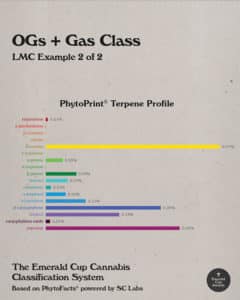
Shopping for products like coffee, wine, chocolate, or cannabis was always confusing. Like so many other consumer goods, connoisseurship and marketing can make the names and terms used to describe these products sound snobby and unapproachable while making the everyday shopper feel naive or even stupid.
Complicated jargon can scare the consumer off from making an informed purchase decision that could lead to a more satisfying experience. Not sure about vintage, flavor notes, or varietals? “Aw, just gimme another bottle of Two-Buck Chuck, and be done with it.”
As the cannabis industry matures, it’s been widely agreed that a more uniform vocabulary and set of standards needs to be agreed upon to more accurately service the end consumer, as well as to help brands, retailers, and frontline budtenders collaborate more effectively.
One obvious solution appears to lie in identifying the effects of various strains and their terpenes, also known as the chemometrics of each cultivar, or chemovar for short.
Of course, there is wide variation among the many chemovars that have been bred over time, and anyone from an Emerald Cup Awards judge to your little brother’s dealer may have also developed their own tasting biases.
In order to provide better guidance for the competition judging, the Emerald Cup’s Tim and Taylor Blake tapped into years of high-level cannabis science analysis and research performed by Alec Dixon, the co-Founder of SC Labs, and Dr. Mark Lewis, President of Napro Research.
Dixon has earned a reputation in the cannabis community as “one of us”. The deep-rooted relationship between SC Labs and the Emerald Cup, helmed by him, has helped to raise standards and shape the approach to cannabis in the California market year after year.
Dr. Lewis has been at the forefront of terpene analysis and laid the groundwork to develop a universal classification system for cannabis.
Combining these two minds, along with 17 past Emerald Cup competitions to draw data and experience from, an easy-to-understand guide grouping classes by dominant terpenes that correlate with their taste, flavor, and effects was created. The Emerald Cup Cannabis Classification System based on PhytoFacts® and powered by SC Labs is designed to change the way we talk about terpenes by highlighting their importance in providing variety in the marketplace and in helping consumers find a full-spectrum experience.
To start, the system has eliminated the previously necessary use of THC/CBD percentages and the antiquated ‘Indica/Sativa/Hybrid’ category model.
While easy and efficient for the early days of cannabis shopping, these percentages and terms have long expired in relevancy as more and more varieties are blended every day and continue blurring the lines of distinction between them.
What is The Emerald Cup Cannabis Classification System based on PhytoFacts powered by SC Labs?
Over recent years, as geneticists and growers seek to create newness and exciting and exclusive products, the broad spectrum of these mixes, blends, and alterations of cannabis was lumped into the ‘Hybrid’ category. Today at almost every dispensary, the menu of offerings reads lopsided and confusing with a majority of products sitting in the middle as a ‘Hybrid’ and very few sitting in a purebred format.
The terms are absent of any explanation to consumers or (budtenders, buyers, and growers for that matter) with little indication of effects, flavor, or terpenes held within the combination the varieties offer.
Since the dawn of cannabis, made-up identifying names, created – at times arbitrarily, fancifully, or symbolically – by leading seed banks and growers became widely known as ‘strains’.
While still a valuable tool for branding and awareness of popular products, the new Emerald Cup system endorses the usage of the term “common chemovars” instead of “common strain names.”
Chemovars can distinguish a varietal, from a hybrid to a purebred or heirloom plant, allowing for an even more nuanced understanding of the dynamics of the specific plant.
Chemovars allow for differentiators to be identified through lab testing and expert tasting, creating “Phytochemical profiles” that can be color mapped and then grouped into similar classes.
Finally, the new classes connect to the well-known cannabinoid terpene names as a further indicator of effects and tasting notes. The system re-introduces the nine primary and secondary terpenes of cannabis back into their classification formula, evolving their usage to show dominant and codominant appearances within each varietal.
To compensate for the guide’s structure of new and familiar differentiator terms, the advisors placed an easy-to-recall combination of names classes in front of all these distinguishers. The Emerald Cup Cannabis Classification System’s new phyto-classification names should feel VERY familiar to the industry and consumers alike.
For example, the class name ‘Jacks + Haze’ is used to identify chemovars that have traditionally been referred to as the more ‘Sativa’ type flavor (Fruity, Pinesol, Haze with Energizing, Cerebral, Artistically-inspiring effects) with a dominant terpene of Terpinolene.
‘Indica’ type effects are now broken into two new classes – ‘Tropical + Floral’ with a dominant terpene of Ocimene (Sweet, Floral, Tropical Fruit with Calming, Soothing, Relaxing effects) and ‘Sweets + Dreams’ with a dominant terpene of Myrcene (Fruity, Sweet, Woody, Hoppy, Herbaceous with Relaxation, Couch-Lock, Analgesic effects).
‘Hybrids,’ traditionally a very broad speaking term, has been broken into two new classifications:
‘OGs + Gas’ with a combination or shifting codominance of terpenes including B. Caryophyllene, Limonene, Myrcene (Gas, Fuel, Sweet, Citrusy and Peppery with Uplifting, Stimulating, Analgesic, Relaxation effects) and ‘Desserts’ with codominance of either Beta-Caryophyllene & Limonene terpenes (Deserts, Doughs, Citrusy & Spicy with Stimulating, Racy, Uplifting, Comforting effects.)
A new class created for the launch system, ‘Exotics’ (with effects varied based on co-terpenes), will represent the rarest terpene profiles entered into the Emerald Cup Competition.
A full breakdown of the new cannabis classifications is found below, along with some sample terpene profile reports provided by SC Labs:

‘Jacks + Haze’ Class
- Mostly ‘Sativa’-leaning varietals
- Tasting notes – Fruity, Pinesol, Haze
- Effects – Energizing, Cerebral, Artistically-inspiring
- Common Cultivars – Classic Trainwreck, Jack Herer, Durban Poison, Super Lemon Haze
- Terpenes Profile: Terpinolene, Caryophyllene, Myrcene

‘Tropical + Floral’ Class
- Mostly ‘Indica’-leaning varietals
- Tasting notes – Sweet, Floral, Tropical Fruit
- Effects – Calming, Soothing, Relaxing
- Common Cultivars – Super Skunk, Hawaiian, In the Pines, Dream Queen
- Terpenes Profile: Ocimene, Myrcene

‘OGs + Gas’ Class
- True ‘Hybrid’ varietals
- Tasting Notes – Gas, Fuel, Sweet, Citrus, and Pepper
- Effect – Uplifting, Stimulating, Analgesic, Relaxation
- Common Cultivars – Classic OG Kush, Chem Dog, Sour Diesel, Gorilla Glue
- Terpenes Profile: Any combination or shifting codominance of Beta-Caryophyllene, Limonene, Myrcene

‘Sweets + Dreams’ Class
- Mostly ‘Indica’-leaning varietals
- Tasting Notes – Fruity, Sweet, Woody, Hoppy, Herbaceous
- Effects – Relaxation, Couch Lock, Analgesic
- Common Cultivars – Blue Dream, Tangie, Forbidden fruit, Grandaddy Purple, Purple Urkel, Grape Ape, Cherry AK, God’s Gift, Purple Punch
- Terpenes Profile: Myrcene, Pinene, Caryophyllene

‘Desserts’ Class
- True ‘Hybrid’ varietals
- Tasting Notes – Deserts, Doughs, Citrusy & Spicy
- Effects – Stimulating, Racy, Uplifting, Comforting
- Common Cultivars – Classic Bubba Kush, GSC, Gelatos, Cakes
- Any shift in codominance of B. Caryophyllene & Limonene

‘Exotics’ (Rare Terpene Combinations) Class
- True ‘Hybrid’ varietals
- Tasting notes – varied based on chemistry of entry
- Effect – varied based on chemistry of entry
- Common Cultivars – rarest terpene profiles entered into the Emerald Cup Competition

With easy-to-understand naming classes and a breakdown of how the system corresponds to taste, effect, and terpene preference, anyone can order a cannabis product anywhere and be satisfied with the results.
It’s so simple that even if somebody’s grandmother walks into a dispensary and says, “I’m looking for Sweets and Dreams,” her budtender will know exactly what she wants. The origin of the product is no longer of importance, and the easy names translate into cultures all over the world.
This concept is only the beginning of where this new classification system could lead. As the industry leans into purchases based on easier-to-navigate classes, it allows the industry to standardize opening doors for younger and older generations and emerging markets alike to approach cannabis safely and with a more satisfactory experience.
Although this scientific, data-driven method is still in its nascent stages, this year at the Emerald Cup Awards which will take place in Los Angeles on May 14, 2022, will be the first testing ground for this new system.
Four main categories made of four individual judging teams will utilize the new Emerald Cup Cannabis Classification System based on Phytofacts® and powered by SC Labs including Flowers, Pre-rolls, Solventless Concentrates, and Hydrocarbon Extracts.
The new system levels the playing field in competition.
Just as in the wine industry it would be unfair to judge a Chardonnay against a Merlot, this new system allows strains with similar profiles to be judged against each other. Later, it will become open-source for usage offered to the California State Fair in July 2022.
As our industry moves towards creating a common language and understanding of terpenes we will be able to make more consistent cannabis decisions across the entire supply chain.
















